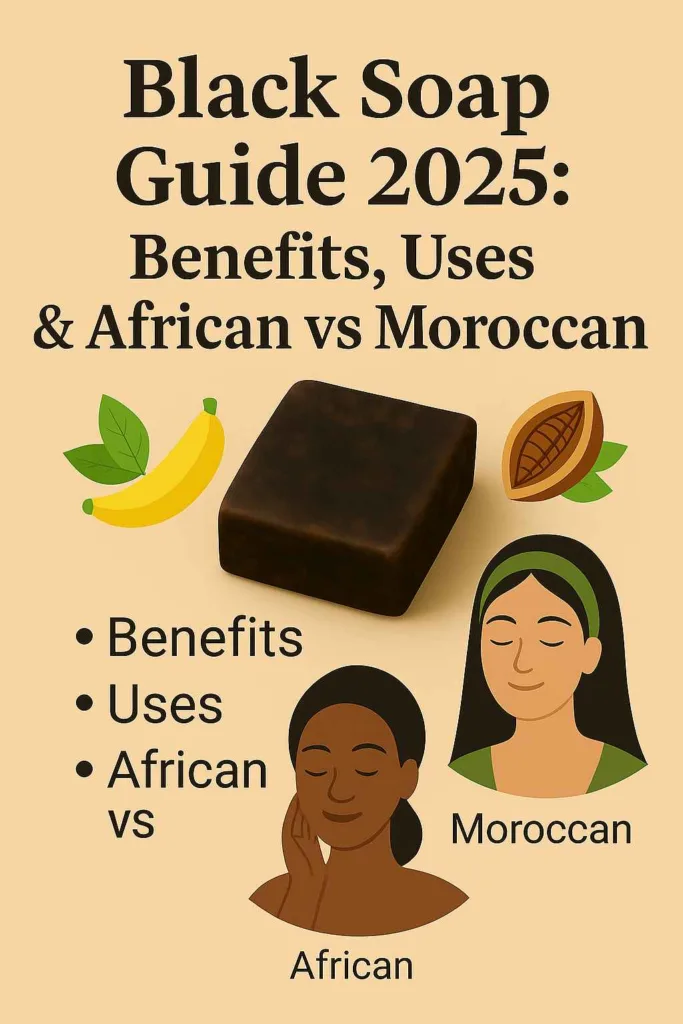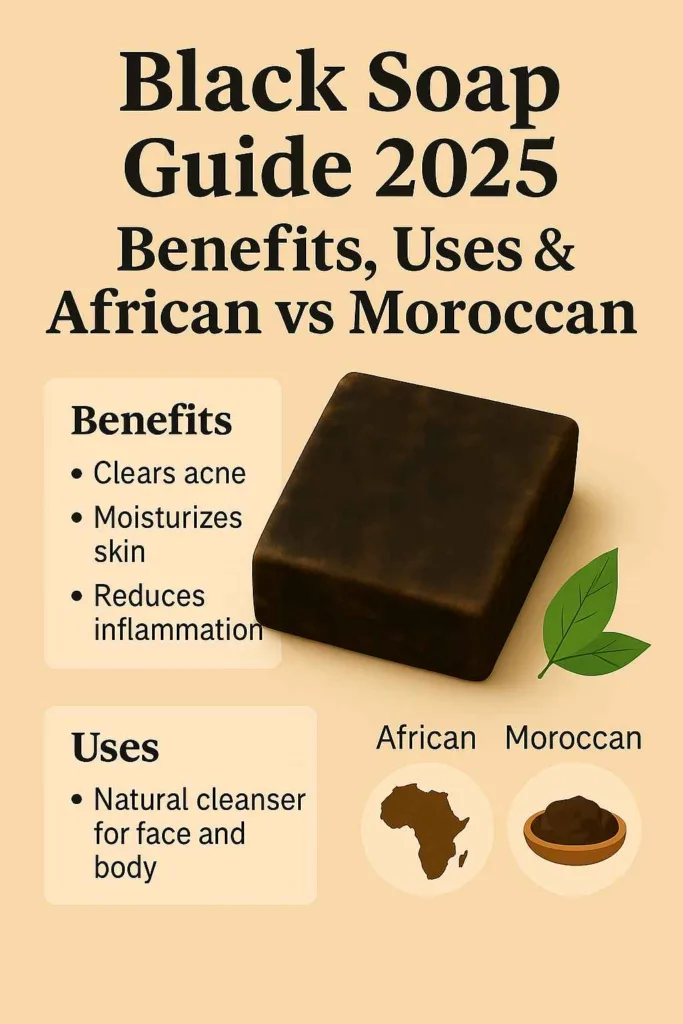One-line summary: Black soap is “natural but not miraculous” – the key lies in matching ingredients and usage to your skin type.
My First Black Soap Experience: Surprises and Pitfalls
My introduction to black soap was a mix of fascination and mistakes. The earthy, smoky scent immediately transported me to something ancient and authentic. The rich, dark lather felt luxurious, but I made the classic beginner error – leaving it on my face for nearly three minutes, thinking “more time equals better results.”
The next morning told a different story. My skin felt uncomfortably tight, almost leather-like, despite using moisturizer. This taught me the fundamental lesson: black soap demands respect for timing and technique. When I adjusted to 60-second maximum contact and proper hydration afterward, the experience transformed completely.

What is Black Soap? Two Main Types and Core Differences
Traditional African black soap originates from West Africa, particularly Ghana and Nigeria. Key ingredients include plantain skin ash, palm kernel oil, shea butter, and sometimes cocoa pod ash. The appearance is distinctively chunky, dark brown to black, often with an uneven, rustic texture that reflects its handmade origins.
Moroccan Black Soap (Beldi/Savon Noir)
Moroccan black soap is fundamentally different – a soft, paste-like substance made primarily from olive oil and crushed olives. Sometimes eucalyptus is added. It’s designed for hammam use with exfoliating gloves and appears as a smooth, dark brown paste.
Comparison Overview
- Usage: African soap for daily cleansing; Moroccan for weekly deep exfoliation
- Texture: African is firm and chunky; Moroccan is soft paste
- Cleansing Power: African is stronger; Moroccan is gentler but more exfoliating
- Suitable for: African suits oily/combination skin; Moroccan works for most skin types
- Price Range: African $5-15; Moroccan $10-25
Personal preference: I find Moroccan black soap more controllable for body use, especially when targeting areas like rough elbows or keratosis pilaris.
Potential Benefits: Science Meets Experience
Black soap’s benefits stem from its unique alkaline pH and natural saponification process. The ash content provides gentle exfoliation, while oils like shea butter offer moisturizing properties. For oily, acne-prone skin, the deep cleansing action can help remove excess sebum and prevent pore blockages.
I’ve observed particularly positive responses among people with combination skin and those dealing with body acne or keratosis pilaris. The mild exfoliating action seems to improve skin texture over time when used consistently but not excessively.
For scalp care, I use black soap once weekly as a clarifying treatment, finding it effectively removes product buildup without the harshness of commercial clarifying shampoos.
Risks and Unsuitable Candidates
The alkaline pH (typically 9-10) can disrupt the skin’s natural acid mantle, leading to dryness and irritation. People with sensitive skin, compromised skin barriers, eczema, or rosacea should approach with extreme caution or avoid entirely.

My personal learning curve included:
- Over-cleansing that led to rebound oil production
- Ignoring the tight feeling, which escalated to flaking
- Using it during a skin barrier repair period (mistake!)
The “natural equals safe” fallacy is particularly relevant here. Botanicals can trigger allergies, and the lack of standardization means quality varies dramatically between suppliers.
Choosing Quality Black Soap: Practical Checklist
Ingredient priorities:
- Short, recognizable ingredient lists
- No artificial colors, SLS, or optical brighteners
- Traditional base ingredients (palm oil, shea butter, plantain ash)
Visual and sensory cues:
- Avoid overly uniform, glossy appearance
- Authentic products have slight color variations
- Smell should be earthy, not heavily perfumed
- Texture should feel slightly rough, not slick
My top three decision factors: Ingredient transparency, reasonable pricing that reflects handmade quality, and supplier reputation with skincare communities.
Proper Usage and 7-Day Adaptation Plan
Basic Technique
- Face: Create rich lather, apply for maximum 60 seconds, avoid eye area
- Body: Use with exfoliating net or traditional hammam glove
- Hair: Monthly clarifying treatment, followed by deep conditioning
7-Day Adaptation Schedule
- Days 1-2: Every other day, 30-second contact time
- Days 3-4: Daily use if tolerated, 45-second maximum
- Days 5-7: Full 60 seconds if skin responds well
Essential aftercare: Immediate moisturization with ceramide-based products or natural oils. Avoid acids or active ingredients on black soap days.
Real Usage Experience and Comparisons
After one use, expect deeply clean skin with potential tightness. After one week, you’ll know if your skin tolerates it well. After one month, texture improvements become noticeable if the product suits you.
Compared to amino acid cleansers, black soap provides more thorough cleansing but requires more careful hydration. Unlike cold-process soaps, traditional black soap’s ash content gives it unique exfoliating properties.
Personal assessment tool: I rate skin tightness on a 1-10 scale post-cleansing. Anything above 6 means I need to adjust technique or frequency.
Common Myths and Reality Checks
“Blacker is better” – False. Color comes from ash content, not effectiveness.
“Natural means no irritation” – Completely false. Natural ingredients can be highly irritating.
“Acne cure” – Misleading. While it may help with oil control, severe acne requires proper medical treatment.
My perspective: Treat black soap as an occasional deep-cleaning tool, not a daily miracle cure. It’s one element of a skincare routine, not a complete solution.
Storage and Practical Tips
Cut large bars into weekly portions. Store in a well-ventilated soap dish away from humidity. For travel, use breathable pouches to prevent mushiness.
My storage hack: I keep cut pieces in a bamboo soap box with drainage holes, which maintains the right moisture level without creating soggy messes.
Frequently Asked Questions

Can sensitive skin use black soap? Generally not recommended. The alkaline pH is too disruptive for compromised barriers.
Is daily use safe? For most people, no. 2-3 times per week maximum for face, daily for body only if well-tolerated.
Pregnancy considerations? While topical use is generally safe, consult healthcare providers about any new skincare during pregnancy.
Intimate area use? Not recommended. Use pH-balanced intimate cleansers instead.
Does it thin the skin? Regular over-use could potentially compromise the skin barrier, but occasional proper use shouldn’t cause thinning.
Remember: Black soap is a tool, not a panacea. Success lies in understanding your skin’s unique needs and responding accordingly.